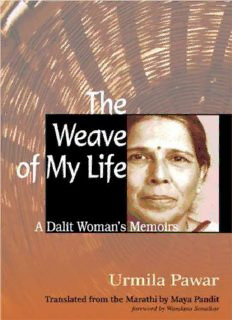
The Weave of My Life : a Dalit Woman's Memoirs PDF
Preview The Weave of My Life : a Dalit Woman's Memoirs
THE WEAVE OF MY LIFE Urmila Pawar The Weave of My Life A DALIT WOMAN’S MEMOIRS URMILA PAWAR TRANSLATED BY MAYA PANDIT COLUMBIA UNIVERSITY PRESS NEW YORK COLUMBIA UNIVERSITY PRESS Publishers Since 1893 New York Chichester, West Sussex cup.columbia.edu Aaydan copyright © 2003 Urmila Pawar; English translation copyright © 2008 Stree. Copyright © 2009 Columbia University Press The Weave of My Life: A Dalit Woman’s Memoir was first published by Stree, an imprint of Bhatkal and Sen, 16 Southern Avenue, Kolkata 700 026, India, in 2008. This edition for sale in North America only All rights reserved E-ISBN 978-0-231-52057-7 Library of Congress Cataloging-in-Publication Data Pavara, Urmila. [Ayadana. English] The weave of my life: a Dalit woman’s memoirs / Urmila Pawar; translated by Maya Pundit. p. cm. Includes bibliographical references. ISBN 978-0-231-14900-6 (cloth: alk. paper) 1. Pavara, Urmila. 2. Authors, Marathi—20th century— Biography. 3. Dalits—India—Maharashtra—Biography. 4. Women—India—Maharashtra—Biography. 5. Political activists—India—Biography. 6. Feminists—India—Biography. 7. Maharashtra (India)— Biography. I. Title. PK2418.P344Z463813 2009 891.4'687109—dc22 [B]2008052564 A Columbia University Press E-book. CUP would be pleased to hear about your reading experience with this e-book at [email protected]. References to Internet Web Sites (URLs) were accurate at the time of writing. Neither the author nor Columbia University Press is responsible for Web sites that may have expired or changed since the book was prepared. To the memory of my mother, Laxmibai Contents Preface Acknowledgments Introduction Wandana Sonalkar A Note on Kinship Terms One Two Three Four Five Six Seven Eight Nine Ten Eleven Twelve Notes Glossary A Note on Readers’ Reactions to Aaydan Illustrations Preface Aaydan! What does it mean? Before plastic began to be utilized for making different objects of everyday use, bamboo was the most common material used to make baskets, containers, and other things of general utility in households. Aaydan is the generic term that refers to all things made from bamboo; awata is another word. Outside the Konkan, the job of weaving bamboo baskets was traditionally assigned to nomadic tribes like the Burud. In the Konkan region, however, it was the Mahar caste that undertook this task. Nobody knows why. Even today, the practice, though considerably weaker, is still prevalent. The other meanings of aaydan are “utensil” and “weapon.” My mother used to weave aaydans. I find that her act of weaving and my act of writing are organically linked. The weave is similar. It is the weave of pain, suffering, and agony that links us. When I look back upon my life, I see the period of conversion from Hinduism to Buddhism as its most significant. Neither the children nor the elders had any idea what religion or conversion meant, of its significance, and about who could act as our guide as far as conversion was concerned. Yet we did convert. The meaning of the transformation began to become clearer to us gradually through the changing rituals and traditions and through the guidance of our political leaders. Dalit houses in the Konkan region were usually not located on the margins of the village but found at its center, probably as a matter of convenience for the upper castes, who could summon us at any time and wanted us at their beck and call. The community was haunted by a sense of perpetual insecurity, fearing that it could be attacked from all four sides in times of conflict. That is why there was always a tendency in our people to shrink within ourselves like a tortoise and proceed at a snail’s pace. This slow pace picked up radically after the conversion to Buddhism. To begin with, there was a tremendous interest in the new religion and in the images of the Buddha and Dr. Ambedkar. Initially it was difficult to replace the images of Gods with those of the Buddha and Ambedkar. The age-old habits of praying to the Gods, worshipping them for some boon or
Description: